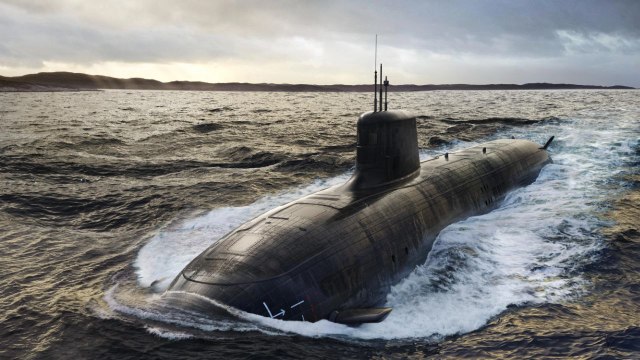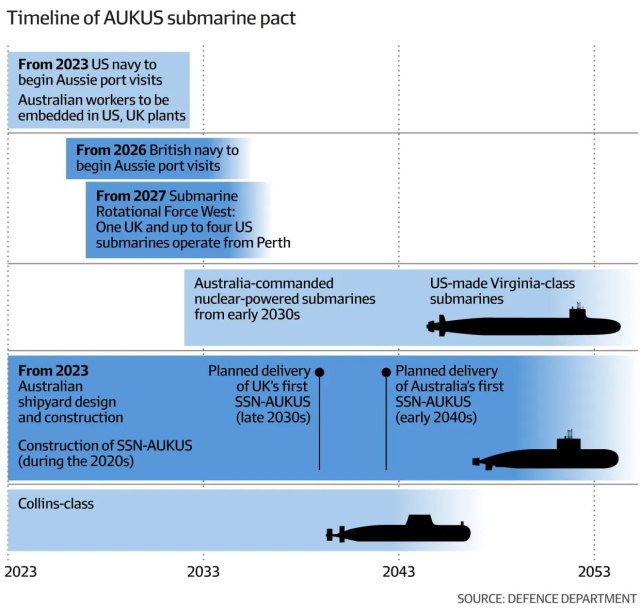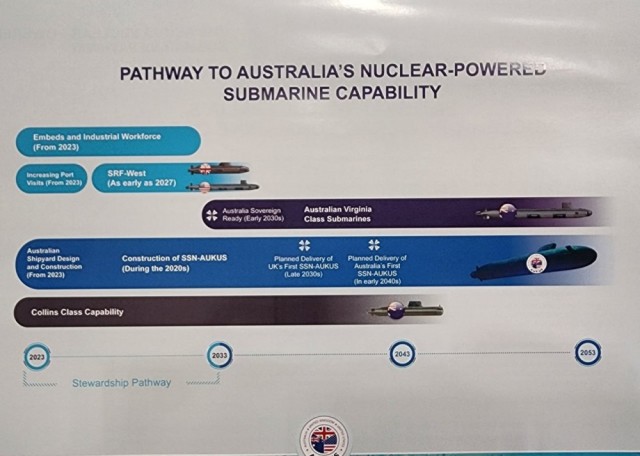On March 13, 2023, a meeting of the leaders of the United States, Great Britain and Australia, representing the expanded security partnership of these three countries, called AUKUS, created in 2021, took place at the American naval base Point Loma in San Diego (California). During the meeting, US President Joe Biden, along with Australian Prime Minister Anthony Albanese and British Prime Minister Rishi Sunak, adopted a joint statement detailing the main AUKUS program - plans for Australia to acquire a fleet of nuclear submarines.

Preliminary image of the promising British-Australian nuclear multipurpose submarine program SSN-AUKUS (c) BAE SystemsA joint statement by the leaders of the three AUKUS countries reads:
In September 2021, Australia, the United Kingdom and the United States announced AUKUS, a new security partnership that should promote a free and open Indo-Pacific region so that it is safe and stable.
The first major initiative of AUKUS was our historic trilateral decision to support Australia in the acquisition of nuclear submarines (PLA) with conventional weapons. Today we are announcing our path to achieving this important opportunity.
Together, we must deliver SSN-AUKUS, a nuclear multi-purpose submarine of trilateral development based on the UK's new generation PLA project, which will include technologies from all three countries, including advanced US submarine technologies. Australia and the UK will operate SSN-AUKUS as their submarine of the future. Australia and the UK are due to begin work on the construction of SSN-AUKUS at their national shipyards during this decade.
In order to deliver nuclear submarines with conventional weapons to Australia as soon as possible, we intend to adhere to the following step-by-step approach, implementing each stage on the basis of mutual obligations of each country:
- Starting in 2023, Australian military and civilian personnel must serve together with the US and UK Navies, as well as at the industrial bases of US and UK submarines to accelerate the training of Australian personnel. The United States plans to increase the number of visits by its PLA to Australian ports starting in 2023, when Australian sailors will join American crews for training and preparation; the UK will increase the number of visits by its PLA to Australia starting in 2026.
- Already in 2027, the United States and the United Kingdom plan to begin advanced rotation of their PLA in Australia in order to accelerate the development of Australian naval personnel, workforce, infrastructure and regulatory framework necessary to create Australia's own PLA potential.
- Starting in the early 2030s, if approved by the US Congress, the United States intends to sell three Virginia-class nuclear submarines to Australia, with the possibility of selling two more, if necessary. This step will allow us to systematically increase Australia's own PLA potential and its technical support capabilities.
- At the end of the 2030s, the UK will deliver its first SSN-AUKUS to the British fleet. Australia will deliver the first SSN-AUKUS built in Australia to the Australian navy in the early 2040s.
This plan is intended to support the development in Australia of the infrastructure, technical capabilities, industry and human capital necessary for the construction, maintenance, operation and management of its own fleet of nuclear submarines with conventional weapons. Australia is fully committed to the responsible management of naval nuclear power plants.
When we announced our partnership with AUKUS in September 2021, we committed ourselves to setting the highest standards for nuclear nonproliferation. The plan we are announcing today is in line with that commitment and reflects our long-standing leadership and respect for the global nuclear nonproliferation regime. We are continuing consultations with the International Atomic Energy Agency to develop an approach to nonproliferation that will set a strong precedent for the acquisition of submarines with a nuclear power plant.
Our plan increases the industrial capacity of all three countries to produce and operate compatible nuclear submarines for decades to come, expands our individual and collective underwater presence in the Indo-Pacific region and contributes to global security and stability. In these results, AUKUS reflects the principle that joint actions taken in partnership can benefit everyone.
The implementation of AUKUS will also require reliable, innovative information exchange and technological cooperation. Our countries are committed to further trilateral cooperation that will strengthen our joint capabilities, improve the exchange of information and technology, and integrate our industrial bases and supply chains, while strengthening the security regimes of each country.
For more than a century, our three countries have stood shoulder to shoulder with other allies and partners, helping to maintain peace, stability and prosperity throughout the world, including in the Indo-Pacific region. We believe in a world that protects freedom and respects human rights, the rule of law, the independence of sovereign States and a rules-based international order. The steps we are announcing today will help us achieve these mutually beneficial goals in the coming decades.
On the part of bmpd, we point out that, thus, according to explanatory publications and reports of Western officials and the media, Australia, within the framework of AUKUS, in accordance with the announced plan, will acquire eight nuclear multipurpose submarines. The total cost of this program for Australia to acquire a PLA and the corresponding industrial and operational base is now estimated at an astronomical sum of 268 to 368 billion Australian dollars (from 179 to 245 billion US dollars).
At the first stage, in the early 2030s, Australia will acquire three Virginia-type submarines from the United States, with the possibility of acquiring two more such boats. It is not yet reported whether these boats will be new, or from the US Navy.
At the second stage, it is planned to build five new type SSN-AUKUS submarines with a planned delivery period from the early 2040s to 2053 at the industrial base being created in Adelaide for the Australian Navy. SSN-AUKUS type boats should be jointly developed by all three countries and built for the British and Australian Navies, thereby based on the program and project of a promising British submarine, now called SSN(R). The main British SSN-AUKUS PLA should be commissioned in the late 2030s. Presumably, the Australian version of the SSN-AUKUS boats will differ from the British one by using an American-made nuclear power plant.
Australian Prime Minister Anthony Albanese announced that the Stirling Naval Base in Perth (Western Australia) will be upgraded to be based on a rotational basis starting in 2027, four American Virginia-type PLA and one British Astute-type PLA, which will make up the so-called rotary submarine force "West" (Submarine Rotational Force-West). The visits of the American PLA there will begin from 2023, and the British ones - from 2026. The cost of the base modernization program for this will be 8 billion Australian dollars.
Australia will also contribute 3 billion Australian dollars over the next four years to the development of the design and shipbuilding base of the PLA in the USA and the UK. In turn, the Prime Minister of the United Kingdom announced on March 13 that over the next two years, the Ministry of Defense of the United Kingdom will be allocated an additional 5 billion pounds for programs for the construction of advanced submarines, including the modernization of the relevant British industrial base and financing the next stage of the SSN-AUKUS program.


Official timelines for the implementation of the nuclear submarine program for Australia under AUKUS (c) Ministry of Defense of Australia
